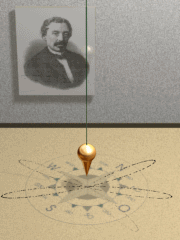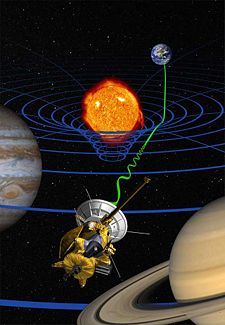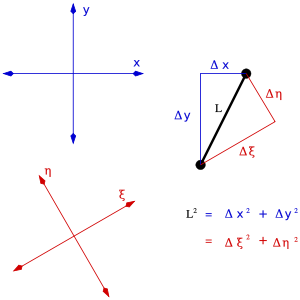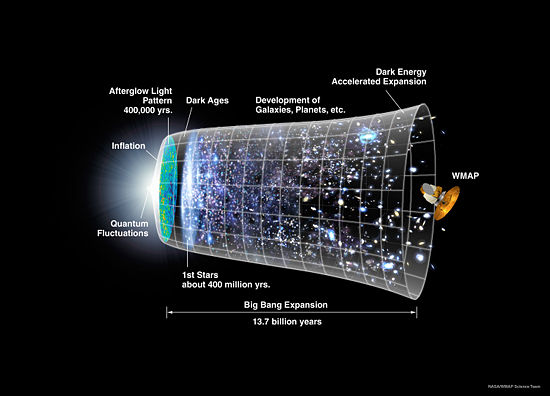Universe
2008/9 Schools Wikipedia Selection. Related subjects: Space (Astronomy)
| Earth in the Universe |
|---|
| Universe |
| Observable universe |
| Large-scale structures |
| Virgo Supercluster |
| Local Group |
| Milky Way Galaxy |
| Orion Arm of the Milky Way |
| Gould Belt |
| Local Bubble |
| Local Interstellar Cloud |
| Solar System |
| Earth |
| Show expanded version with scale |
The Universe is most commonly defined as everything that physically exists: the entirety of space and time, all forms of matter, energy and momentum, and the physical laws and constants that govern them. However, the term "universe" may be used in slightly different contextual senses, denoting such concepts as the cosmos the world or Nature.
Astronomical observations indicate that the universe is 13.73 ± 0.12 billion years old and at least 93 billion light years across. The event that started the universe is called the Big Bang. At this point in time all matter and energy of the observable universe was concentrated in one point of infinite density. After the Big Bang the universe started to expand to its present form. Since special relativity states that matter cannot exceed the speed of light, in a fixed space-time, it may seem paradoxical that two galaxies can be separated by 93 billion light years in 13 billion years; however, this separation is a natural consequence of general relativity. Stated simply, space can expand with no intrinsic limit on its rate; thus, two galaxies can separate more quickly than the speed of light if the space between them grows. Experimental measurements such as the redshifts and spatial distribution of distant galaxies, the cosmic microwave background radiation, and the relative percentages of the lighter chemical elements, support this theoretical expansion and, more generally, the Big Bang theory, which proposes that space itself was created ex nihilo at a specific time in the past. Recent observations have shown that this expansion is accelerating, and that most of the matter and energy in the universe is fundamentally different from that observed on Earth and not directly observable (cf. dark energy). The imprecision of current observations has hindered predictions of the ultimate fate of the universe.
Experiments suggest that the universe has been governed by the same physical laws and constants throughout its extent and history. The dominant force at cosmological distances is gravity, and general relativity is currently the most accurate theory of gravitation. The remaining three fundamental forces and the particles on which they act are described by the Standard Model. The universe has at least three dimensions of space and one of time, although extremely small additional dimensions cannot be ruled out experimentally. Spacetime appears to be smoothly and simply connected, and space has very small mean curvature, so that Euclidean geometry is accurate on the average throughout the universe.
According to some speculations, this universe may be one of many disconnected universes, which are collectively denoted as the multiverse. In one theory, there is an infinite variety of universes, each with different physical constants. In another theory, new universes are spawned with every quantum measurement. By definition, these speculations cannot currently be tested experimentally.
Throughout recorded history, several cosmologies and cosmogonies have been proposed to account for observations of the universe. The earliest quantitative models were developed by the ancient Greeks, who proposed that the universe possesses infinite space and has existed eternally, but contains a single set of concentric spheres of finite size - corresponding to the fixed stars, the Sun and various planets - rotating about a spherical but unmoving Earth. Over the centuries, more precise observations and improved theories of gravity led to Copernicus' heliocentric model and the Newtonian model of the solar system, respectively. Further improvements in astronomy led to the characterization of the Milky Way, and the discovery of other galaxies and the microwave background radiation; careful studies of the distribution of these galaxies and their spectral lines have led to much of modern cosmology.
| Physical cosmology | ||||||||||||||
 |
||||||||||||||
| Universe · Big Bang Age of the universe Timeline of the Big Bang Ultimate fate of the universe
|
||||||||||||||
Etymology, synonyms and definitions
The word universe derives from the Old French word univers, which in turn derives from the Latin word universum. The Latin word was used by Cicero and later Latin authors in many of the same senses as the modern English word is used. The Latin word derives from the poetic contraction unvorsum — first used by Lucretius in Book IV (line 262) of his De rerum natura (On the Nature of Things) — which connects un, uni (the combining form of unus, or "one") with vorsum, versum (a noun made from the perfect passive participle of vertere, meaning "something rotated, rolled, changed"). Lucretius used the word in the sense "everything rolled into one, everything combined into one".
An alternative interpretation of unvorsum is "everything rotated as one" or "everything rotated by one". In this sense, it may be considered a translation of an earlier Greek word for the universe, περιφορα, "something transported in a circle", originally used to describe a course of a meal, the food being carried around the circle of dinner guests. This Greek word refers to an early Greek model of the universe, in which all matter was contained within rotating spheres centered on the Earth; according to Aristotle, the rotation of the outermost sphere was responsible for the motion and change of everything within. It was natural for the Greeks to assume that the Earth was stationary and that the heavens rotated about the Earth, since careful astronomical and physical measurements (such as the Foucault pendulum) are required to prove otherwise.
The most common term for "universe" among the ancient Greek philosophers from Pythagoras onwards was το παν (The All), defined as all matter (το ολον) and all space (το κενον). Other synonyms for the universe among the ancient Greek philosophers included κοσμος (meaning the world, the cosmos) and φυσις (meaning Nature, from which we derive the word physics). The same synonyms are found in Latin authors (totum, mundus, natura) and survive in modern languages, e.g., the German words Das All, Weltall, and Natur for universe. The same synonyms are found in English, such as everything (as in the theory of everything), the cosmos (as in cosmology), the world (as in the many-worlds hypothesis), and Nature (as in natural laws or natural philosophy).
Broadest definition: reality and probability
The broadest definition of the universe is found in De divisione naturae by the medieval philosopher Johannes Scotus Eriugena, who defined it as simply everything: everything that exists and everything that does not exist. Time is not considered in Eriugena's definition; thus, his definition includes everything that exists, has existed and will exist, as well as everything that does not exist, has never existed and will never exist. This all-embracing definition was not adopted by most later philosophers, but it is relevant in quantum physics, particularly the path-integral formulation of Feynman. According to that formulation, the probability amplitudes for the various outcomes of an experiment given a perfectly defined initial state of the system are determined by summing over all possible paths by which the system could progress from the initial to final state. Naturally, an experiment can have only one outcome; in other words, only one possible outcome is made real in this universe, via the mysterious process of quantum measurement, also known as the collapse of the wavefunction (but see the many-worlds hypothesis below in the Multiverse section). In this well-defined mathematical sense, even that which does not exist (all possible paths) can influence that which does finally exist (the experimental measurement). As a specific example, every electron is intrinsically identical to every other; therefore, probability amplitudes must be computed allowing for the possibility that they exchange positions, something known as exchange symmetry. This conception of the universe embracing both the existent and the non-existent is loosely related to the Buddhist doctrines of shunyata and interdependent development of reality, and to Gottfried Leibniz's more modern concepts of contingency and the identity of indiscernibles.
Definition as reality
More customarily, the universe is defined as everything that exists, has existed and will exist. According to this definition and our present understanding, the universe consists of three elements: space and time, collectively known as space-time or the vacuum; matter and various forms of energy and momentum occupying space-time; and the physical laws that govern the first two. These elements will be discussed in greater detail below. A related definition of "universe" is everything that exists at a single moment of time, such as the present, as in the sentence "The universe is now bathed uniformly in microwave radiation".
The three elements of the universe (spacetime, matter-energy, and physical law) correspond roughly to the ideas of Aristotle. In his book The Physics (Φυσικης, from which we derive the word "physics"), Aristotle divided το παν (everything) into three roughly analogous elements: matter (the stuff of which the universe is made), form (the arrangement of that matter in space) and change (how matter is created, destroyed or altered in its properties, and similarly, how form is altered). Physical laws were conceived as the rules governing the properties of matter, form and their changes. Later philosophers such as Lucretius, Averroes, Avicenna and Baruch Spinoza altered or refined these divisions; for example, Averroes and Spinoza discern natura naturans (the active principles governing the universe) from natura naturata, the passive elements upon which the former act.
Definition as connected space-time

It is possible to conceive of disconnected space-times, each existing but unable to interact with one another. An easily visualized metaphor is a group of separate soap bubbles, in which observers living on one soap bubble cannot interact with those on other soap bubbles, even in principle. According to one common terminology, each "soap bubble" of space-time is denoted as a universe, whereas our particular space-time is denoted as the Universe, just as we call our moon the Moon. The entire collection of these separate space-times is denoted as the multiverse. In principle, the other unconnected universes may have different dimensionalities and topologies of space-time, different forms of matter and energy, and different physical laws and physical constants, although it is impossible to know for sure. These multiverses could also exist within other universes, in the same way that the interior of a black hole is discontinuous with our world; once something goes in it will never come out.
Definition as observable reality
According to a still more restrictive definition, the universe is everything within our connected space-time that could ever interact with us and vice versa. According to the general theory of relativity, some regions of space may never interact with ours even in the lifetime of the universe, due to the finite speed of light and the expansion of space. For example, radio messages sent from Earth may never reach some regions of space, even if the universe lives forever; space may expand faster than light can cover it. It is worth emphasizing that those distant regions of space are taken to exist and be part of reality as much as we are; yet we can never interact with them. The spatial region within which we can affect and be affected is denoted as the observable universe. Strictly speaking, the observable universe depends on the observer. By traveling, an observer can come into contact with a greater region of space-time than an observer who remains still, so that the observable universe for the former is larger than for the latter; nevertheless, even the most rapid traveler may not be able to interact with all of space. Typically, the observable universe is taken to mean the universe observable from our vantage point in the Milky Way galaxy.
Size, age, contents, structure, and laws
The universe is very large and possibly infinite in volume; the observable matter is spread over a space at least 93 billion light years across. For comparison, the diameter of a typical galaxy is only 30,000 light-years, and the typical distance between two neighboring galaxies is only 3 million light-years. As an example, our Milky Way galaxy is roughly 100,000 light years in diameter, and our nearest sister galaxy, the Andromeda Galaxy, is located roughly 2.5 million light years away.

The observable matter is spread uniformly (homogeneously) throughout the universe, when averaged over distances longer than 300 million light-years. However, on smaller length-scales, matter is observed to form "clumps", i.e., to cluster hierarchically; many atoms are condensed into stars, most stars into galaxies, most galaxies into clusters, superclusters and, finally, the largest-scale structures such as the Great Wall of galaxies. The observable matter of the universe is also spread isotropically, meaning that no direction of observation seems different from any other; each region of the sky has roughly the same content. The universe is also bathed in a highly isotropic microwave radiation that corresponds to a thermal equilibrium blackbody spectrum of roughly 2.725 Kelvin. The hypothesis that the large-scale universe is homogeneous and isotropic is known as the cosmological principle, which is supported by astronomical observations.
The present overall density of the universe is very low, roughly 9.9 × 10-30 grams per cubic centimetre. This mass-energy appears to consist of 73% dark energy, 23% cold dark matter and 4% ordinary matter. Thus the density of atoms is on the order of a single hydrogen atom for every four cubic meters of volume. The properties of dark energy and dark matter are largely unknown. Dark matter gravitates as ordinary matter, and thus works to slow the expansion of the universe; by contrast, dark energy accelerates its expansion.
The universe is old and evolving. The most precise estimate of the universe's age is 13.73±0.12 billion years old, based on observations of the cosmic microwave background radiation. Independent estimates (based on measurements such as radioactive dating) agree, although they are less precise, ranging from 11-20 billion years to 13–15 billion years. The universe has not been the same at all times in its history; for example, the relative populations of quasars and galaxies have changed and space itself appears to have expanded. This expansion accounts for how Earth-bound scientists can observe the light from a galaxy 30 billion light years away, even if that light has traveled for only 13 billion years; the very space between them has expanded. This expansion is consistent with the observation that the light from distant galaxies has been redshifted; the photons emitted have been stretched to longer wavelengths and lower frequency during their journey. The rate of this spatial expansion is accelerating, based on studies of Type Ia supernovae and corroborated by other data.
The relative fractions of different chemical elements — particularly the lightest atoms such as hydrogen, deuterium and helium — seem to be identical throughout the universe and throughout its observable history. The universe seems to have much more matter than antimatter, an asymmetry possibly related to the observations of CP violation. The universe appears to have no net electric charge, and therefore gravity appears to be the dominant interaction on cosmological length scales. The universe appears to have no net momentum and angular momentum. The absence of net charge and momentum would follow from accepted physical laws ( Gauss's law and the non-divergence of the stress-energy-momentum pseudotensor, respectively), if the universe were finite.
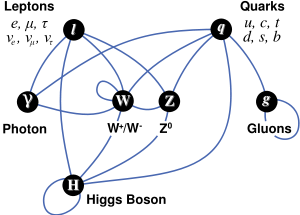
The universe appears to have a smooth spacetime continuum consisting of three spatial dimensions and one temporal (time) dimension. On the average, space is observed to be very nearly flat (close to zero curvature), meaning that Euclidean geometry is experimentally true with high accuracy throughout most of the universe. Spacetime also appears to have a simply connected topology, at least on the length-scale of the observable universe. However, present observations cannot exclude the possibilities that the universe has more dimensions and that its spacetime may have a multiply connected global topology, in analogy with the cylindrical or toroidal topologies of two-dimensional spaces.
The universe appears to be governed throughout by the same physical laws and physical constants. According to the prevailing Standard Model of physics, all matter is composed of three generations of leptons and quarks, both of which are fermions. These elementary particles interact via at most three fundamental interactions: the electroweak interaction which includes electromagnetism and the weak nuclear force; the strong nuclear force described by quantum chromodynamics; and gravity, which is best described at present by general relativity. The first two interactions can be described by renormalized quantum field theory, and are mediated by gauge bosons that correspond to a particular type of gauge symmetry. A renormalized quantum field theory of general relativity has not yet been achieved, although various forms of string theory seem promising. The theory of special relativity is believed to hold throughout the universe, provided that the spatial and temporal length scales are sufficiently short; otherwise, the more general theory of general relativity must be applied. There is no explanation for the particular values that physical constants appear to have throughout our universe, such as Planck's constant h or the gravitational constant G. Several conservation laws have been identified, such as the conservation of charge, momentum, angular momentum and energy; in many cases, these conservation laws can be related to symmetries or mathematical identities.
Historical models
Many models of the cosmos (cosmologies) and its origin (cosmogonies) have been proposed, based on the then available data and conceptions of the universe. Initially, cosmologies and cosmogonies were based on narratives of gods acting in various ways. The Greeks were the first to propose theories of an impersonal universe governed by physical laws. Over the centuries, improvements in astronomical observations and theories of motion and gravitation led to ever more accurate descriptions of the universe. The modern era of cosmology began with Albert Einstein's 1915 general theory of relativity, which made it possible to quantitatively predict the origin, evolution and conclusion of the universe as a whole. Most accepted theories of cosmology are based on general relativity and, more specifically, the predicted Big Bang; however, still more careful measurements are required to determine which theory is correct.
Creation myths
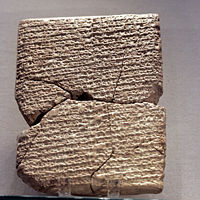
Many cultures have stories describing the creation of the world, which may be roughly grouped into common types. In one type of story, the world is born from a world egg; such stories include the Finnish epic poem Kalevala, the Chinese story of Pangu or the Indian Brahmanda Purana. In related stories, the creation is caused by a single god emanating or producing something by themselves, as in Buddhist concept of Adi-Buddha, the ancient Greek story of Gaia (Mother Earth), the Aztec goddess Coatlicue or the ancient Egyptian god Atum. In another type of story, the world is created from the union of male and female deities, as in the Maori story of Rangi and Papa. In other stories, the universe is created by crafting it from pre-existing materials, such as the corpse of a dead god - as from Tiamat in the Babylonian epic Enuma Elish or from the giant Ymir in Norse mythology - or from chaotic materials, as in Izanagi and Izanami in Japanese mythology. In another type of story, the world is created by the command of a divinity, as in the ancient Egyptian story of Ptah or the Biblical account in Genesis, wherein some Christians believe that the universe was created 6,000-10,000 years ago, while other Christians believe that the Creation account is compatible with modern science. In other stories, the universe emanates from fundamental principles, such as Brahman and Prakrti, or the yin and yang of the Tao.

Philosophical models
The first philosophical models of the universe were developed by the pre-Socratic philosophers. The earliest Greek philosophers noted that appearances can be deceiving, and sought to understand the underlying reality behind the appearances. In particular, they noted the ability of matter to change forms (e.g., ice to water to steam) and several philosophers proposed that all the apparently different materials of the world (wood, metal, etc.) are all different forms of a single material, the arche. The first to do so was Thales, who called this material Water. Following him, Anaximenes called it Air, and posited that there must be attractive and repulsive forces that cause the arche to condense or dissociate into different forms. Empedocles proposed that multiple fundamental materials were necessary to explain the diversity of the universe, and proposed that all four classical elements (Earth, Air, Fire and Water) existed, albeit in different combinations and forms. This four-element theory was adopted by many of the subsequent philosophers. Some philosophers before Empedocles advocated less material things for the arche; Heraclitus argued for a Logos, Pythagoras believed that all things were composed of numbers, whereas Thales' student, Anaximander, proposed that everything was composed of a chaotic substance known as apeiron, roughly corresponding to the modern concept of a quantum foam. Various modifications of the apeiron theory were proposed, most notably that of Anaxagoras, which proposed that the various matter in the world was spun off from a rapidly rotating apeiron, set in motion by the principle of Nous (Mind). Still other philosophers — most notably Leucippus and Democritus — proposed that the universe was composed of indivisible atoms moving through empty space, a vacuum; Aristotle opposed this view ("Nature abhors a vacuum") on the grounds that resistance to motion increases with density; hence, empty space should offer no resistance to motion, leading to the possibility of infinite speed.
Although Heraclitus argued for eternal change, his rough contemporary Parmenides made the radical suggestion that all change is an illusion, that the true underlying reality is eternally unchanging and of a single nature. Parmenides denoted this reality as το εν (The One). Parmenides' theory seemed implausible to many Greeks, but his student Zeno of Elea challenged them with several famous paradoxes. Aristotle resolved these paradoxes by developing the notion of an infinitely divisible continuum, and applying it to space and time.
Astronomical models
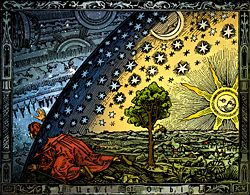
More practical Greek philosophers were concerned with developing models of the universe that would account for the observed motion of the stars and planets. The first coherent model was proposed by Eudoxus of Cnidos. According to this model, space and time are infinite and eternal, the Earth is spherical and stationary, and all other matter is confined to rotating concentric spheres. This model was refined by Callippus and Aristotle, and brought into nearly perfect agreement with astronomical observations by Ptolemy. The success of this model is largely due to the mathematical fact that any function (such as the position of a planet) can be decomposed into a set of circular functions (the Fourier modes). However, not all Greek scientists accepted the geocentric model of the Universe. Aristarchus of Samos was the first astronomer to propose a heliocentric model. Though the original text has been lost, a reference in Archimedes' book The Sand Reckoner describes Aristarchus' heliocentric theory. Archimedes wrote: (translated into English)
You King Gelon are aware the 'universe' is the name given by most astronomers to the sphere the center of which is the center of the Earth, while its radius is equal to the straight line between the center of the Sun and the center of the Earth. This is the common account as you have heard from astronomers. But Aristarchus has brought out a book consisting of certain hypotheses, wherein it appears, as a consequence of the assumptions made, that the universe is many times greater than the 'universe' just mentioned. His hypotheses are that the fixed stars and the Sun remain unmoved, that the Earth revolves about the Sun on the circumference of a circle, the Sun lying in the middle of the orbit, and that the sphere of fixed stars, situated about the same center as the Sun, is so great that the circle in which he supposes the Earth to revolve bears such a proportion to the distance of the fixed stars as the centre of the sphere bears to its surface.
Aristarchus thus believed the stars to be very far away, and saw this as the reason why there was no visible parallax, that is, an observed movement of the stars relative to each other as the Earth moved around the Sun. The stars are in fact much farther away than the distance that was generally assumed in ancient times, which is why stellar parallax is only detectable with telescopes. The geocentric model, consistent with planetary parallax, was assumed to be an explanation for the unobservability of the parallel phenomenon, stellar parallax. The rejection of the heliocentric view was apparently quite strong, as the following passage from Plutarch suggests (On the Apparent Face in the Orb of the Moon):
Cleanthes [a contemporary of Aristarchus and head of the Stoics] thought it was the duty of the Greeks to indict Aristarchus of Samos on the charge of impiety for putting in motion the Hearth of the universe [i.e. the earth], . . . supposing the heaven to remain at rest and the earth to revolve in an oblique circle, while it rotates, at the same time, about its own axis.
The only other astronomer from antiquity known by name who supported Aristarchus' heliocentric model was Seleucus of Seleucia, a Greek astronomer who lived a century after Aristarchus.
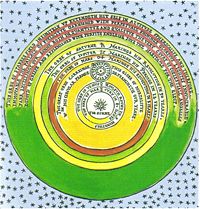
The Aristotelian model was accepted for roughly two millennia, until Copernicus revived Aristarchus' theory that the astronomical data could be explained more plausibly if the earth rotated on its axis and if the sun were placed at the centre of the universe
| “ | In the centre rests the sun. For who would place this lamp of a very beautiful temple in another or better place than this wherefrom it can illuminate everything at the same time? | ” |
|
—Copernicus, in Chapter 10, Book 1 of De Revolutionibus Orbium Coelestrum (1543) |
||
As noted by Copernicus himself, the suggestion that the Earth rotates was very old, dating at least to Philolaus (c. 450 BC), Heraclides Ponticus (c. 350 BC) and Ecphantus the Pythagorean. Roughly a century before Copernicus, Nicholas of Cusa also proposed that the Earth rotates on its axis in his book, On Learned Ignorance (1440). Copernicus' heliocentric model allowed the stars to be placed uniformly through the (infinite) space surrounding the planets, as first proposed by Thomas Digges in his Perfit Description of the Caelestiall Orbes according to the most aunciente doctrine of the Pythagoreans, latelye revived by Copernicus and by Geometricall Demonstrations approved (1576). Giordano Bruno accepted the idea that space was infinite and filled with solar systems similar to our own; for the publication of this view, he was burned at the stake in the Campo dei Fiori in Rome on 17 February 1600.
This cosmology was accepted provisionally by Isaac Newton, Christiaan Huygens and later scientists, although it had several paradoxes that were resolved only with the development of general relativity. The first of these was that it assumed that space and time were infinite, and that the stars in the universe had been burning forever; however, since stars are constantly radiating energy, a finite star seems inconsistent with the radiation of infinite energy. Secondly, Edmund Halley (1720) and Jean-Philippe de Cheseaux (1744) noted independently that the assumption of an infinite space filled uniformly with stars would lead to the prediction that the nighttime sky would be as bright as the sun itself; this became known as Olbers' paradox in the 19th century. Third, Newton himself showed that an infinite space uniformly filled with matter would cause infinite forces and instabilities causing the matter to be crushed inwards under its own gravity. This instability was clarified in 1902 by the Jeans instability criterion. One solution to these latter two paradoxes is the Charlier universe, in which the matter is arranged hierarchically (systems of orbiting bodies that are themselves orbiting in a larger system, ad infinitum) in a fractal way such that the universe has a negligibly small overall density; such a cosmological model had also been proposed earlier in 1761 by Johann Heinrich Lambert. A significant astronomical advance of the 18th century was the realization by Thomas Wright, Immanuel Kant and others that stars are not distributed uniformly throughout space; rather, they are grouped into galaxies.
The modern era of physical cosmology began in 1917, when Albert Einstein first applied his general theory of relativity to model the structure and dynamics of the universe. This theory and its implications will be discussed in more detail in the following section.
Theoretical models
Of the four fundamental interactions, gravitation is dominant at cosmological length scales; that is, the other three forces are believed to play a negligible role in determining structures at the level of planets, stars, galaxies and larger-scale structures. Since all matter and energy gravitate, gravity's effects are cumulative; by contrast, the effects of positive and negative charges tend to cancel one another, making electromagnetism relatively insignificant on cosmological length scales. The remaining two interactions, the weak and strong nuclear forces, decline very rapidly with distance; their effects are confined mainly to sub-atomic length scales.
General theory of relativity
Given gravitation's predominance in shaping cosmological structures, accurate predictions of the universe's past and future require an accurate theory of gravitation. The best theory available is Albert Einstein's general theory of relativity, which has passed all experimental tests hitherto. However, since rigorous experiments have not been carried out on cosmological length scales, general relativity could conceivably be inaccurate. Nevertheless, its cosmological predictions appear to be consistent with observations, so there is no compelling reason to adopt another theory.
General relativity provides of a set of ten nonlinear partial differential equations for the spacetime metric ( Einstein's field equations) that must be solved from the distribution of mass-energy and momentum throughout the universe. Since these are unknown in exact detail, cosmological models have been based on the cosmological principle, which states that the universe is homogeneous and isotropic. In effect, this principle asserts that the gravitational effects of the various galaxies making up the universe are equivalent to those of a fine dust distributed uniformly throughout the universe with the same average density. The assumption of a uniform dust makes it easy to solve Einstein's field equations and predict the past and future of the universe on cosmological time scales.
Einstein's field equations include a cosmological constant Λ, that corresponds to an energy density of empty space. Depending on its sign, the cosmological constant can either slow (negative Λ) or accelerate (positive Λ) the expansion of the universe. Although many scientists, including Einstein, had speculated that Λ was zero, recent astronomical observations of type Ia supernovae have detected a large amount of " dark energy" that is accelerating the universe's expansion. Preliminary studies suggest that this dark energy corresponds to a positive Λ, although alternative theories cannot be ruled out as yet. Russian physicist Zel'dovich suggested that Λ is a measure of the zero-point energy associated with virtual particles of quantum field theory, a pervasive vacuum energy that exists everywhere, even in empty space. Evidence for such zero-point energy is observed in the Casimir effect.
Special relativity and space-time
The universe has at least three spatial and one temporal (time) dimension. It was long thought that the spatial and temporal dimensions were different in nature and independent of one another. However, according to the special theory of relativity, spatial and temporal separations are interconvertible (within limits) by changing one's motion.
To understand this interconversion, it is helpful to consider the analogous interconversion of spatial separations along the three spatial dimensions. Consider the two endpoints of a rod of length L. The length can be determined from the differences in the three coordinates Δx, Δy and Δz of the two endpoints in a given reference frame
- L2 = Δx2 + Δy2 + Δz2
using the Pythagorean theorem. In a rotated reference frame, the coordinate differences differ, but they give the same length
- L2 = Δξ2 + Δη2 + Δζ2
Thus, the coordinates differences (Δx, Δy, Δz) and (Δξ, Δη, Δζ) are not intrinsic to the rod, but merely reflect the reference frame used to describe it; by contrast, the length L is an intrinsic property of the rod. The coordinate differences can be changed without affecting the rod, by rotating one's reference frame.
The analogy in spacetime is called the interval between two events; an event is defined as a point in spacetime, a specific position in space and a specific moment in time. The spacetime interval between two events is given by
where c is the speed of light. According to special relativity, one can change a spatial and time separation (L1, Δt1) into another (L2, Δt2) by changing one's reference frame, as long as the change maintains the spacetime interval s. Such a change in reference frame corresponds to changing one's motion; in a moving frame, lengths and times are different from their counterparts in a stationary reference frame. The precise manner in which the coordinate and time differences change with motion is described by the Lorentz transformation.
Solving Einstein's field equations
In non-Cartesian (non-square) or curved coordinate systems, the Pythagorean theorem holds only on infinitesimal length scales and must be augmented with a more general metric tensor gμν, which can vary from place to place and which describes the local geometry in the particular coordinate system. However, assuming the cosmological principle that the universe is homogeneous and isotropic everywhere, every point in space is like every other point; hence, the metric tensor must be the same everywhere. That leads to a single form for the metric tensor, called the Friedmann-Lemaître-Robertson-Walker metric
where (r, θ, φ) correspond to a spherical coordinate system. This metric has only two undetermined parameters: an overall length scale R that can vary with time, and a curvature index k that can be only 0, 1 or -1, corresponding to flat Euclidean geometry, or spaces of positive or negative curvature. In cosmology, solving for the history of the universe is done by calculating R as a function of time, given k and the value of the cosmological constant Λ, which is a (small) parameter in Einstein's field equations. The equation describing how R varies with time is known as the Friedmann equation, after its inventor, Alexander Friedmann.
The solutions for R(t) depend on k and Λ, but some qualitative features of such solutions are general. First and most importantly, the length scale R of the universe can remain constant only if the universe is perfectly isotropic with positive curvature (k=1) and has one precise value of density everywhere, as first noted by Albert Einstein. However, this equilibrium is unstable and since the universe is known to be inhomogeneous on smaller scales, R must change, according to general relativity. When R changes, all the spatial distances in the universe change in tandem; there is an overall expansion or contraction of space itself. The accounts for the observation that galaxies appear to be flying apart; the space between them is stretching. The stretching of space also accounts for the apparent paradox that two galaxies can be 40 billion light years apart, although they started from the same point 13.7 billion years ago and never moved faster than the speed of light.
Second, all solutions suggest that there was a gravitational singularity in the past, when R goes to zero and matter and energy became infinitely dense. It may seem that this conclusion is uncertain since it is based on the questionable assumptions of perfect homogeneity and isotropy (the cosmological principle) and that only the gravitational interaction is significant. However, the Penrose-Hawking singularity theorems show that a singularity should exist for very general conditions. Hence, according to Einstein's field equations, R grew rapidly from an unimaginably hot, dense state that existed immediately following this singularity (when R had a small, finite value); this is the essence of the Big Bang model of the universe. A common misconception is that the Big Bang model predicts that matter and energy exploded from a single point in space and time; that is false. Rather, space itself was created in the Big Bang and imbued with a fixed amount of energy and matter distributed uniformly throughout; as space expands (i.e., as R(t) increases), the density of that matter and energy decreases.
|
Space has no boundary - that is empirically more certain than any external observation. However, that does not imply that space is infinite...(translated, original German) |
| Bernhard Riemann (Habilitationsvortrag, 1854) |
Third, the curvature index k determines the sign of the mean spatial curvature of spacetime averaged over length scales greater than a billion light years. If k=1, the curvature is positive and the universe has a finite volume. Such universes are often visualized as a three-dimensional sphere S3 embedded in a four-dimensional space. Conversely, if k is zero or negative, the universe may have infinite volume, depending on its overall topology. It may seem counter-intuitive that an infinite and yet infinitely dense universe could be created in a single instant at the Big Bang when R=0, but exactly that is predicted mathematically when k does not equal 1. For comparison, an infinite plane has zero curvature but infinite area, whereas an infinite cylinder is finite in one direction and a torus is finite in both. A toroidal universe could behave like a normal universe with periodic boundary conditions, as seen in "wrap-around" video games such as Asteroids; a traveler crossing an outer "boundary" of space going outwards would reappear instantly at another point on the boundary moving inwards.
The ultimate fate of the universe is still unknown, since it depends critically on the curvature index k and the cosmological constant Λ. If the universe is sufficiently dense, k equals +1, meaning that its average curvature throughout is positive and the universe will eventually recollapse in a Big Crunch, possibly starting a new universe in a Big Bounce. Conversely, if the universe is insufficiently dense, k equals 0 or -1 and the universe will expand forever, cooling off and eventually becoming inhospitable for all life, as the stars die and all matter coalesces into black holes (the Big Freeze and the heat death of the universe). As noted above, recent data suggests that the expansion of the universe is not decreasing as originally expected, but accelerating; if this continues indefinitely, the universe will eventually rip itself to shreds (the Big Rip). Experimentally, the universe has an overall density that is very close to the critical value between recollapse and eternal expansion; more careful astronomical observations are needed to decide the question.
Big Bang model
The prevailing Big Bang model accounts for many of the experimental observations described above, such as the correlation of distance and redshift of galaxies, the universal ratio of hydrogen:helium atoms, and the ubiquitous, isotropic microwave radiation background. As noted above, the redshift arises from the metric expansion of space; as the space itself expands, the wavelength of a photon traveling through space likewise increases, decreasing its energy. The longer a photon has been traveling, the more expansion it has undergone; hence, older photons from more distant galaxies are the most red-shifted. Determining the correlation between distance and redshift is an important problem in experimental physical cosmology.

Other experimental observations can be explained by combining the overall expansion of space with nuclear and atomic physics. As the universe expands, the energy density of the electromagnetic radiation decreases more quickly than does that of matter, since the energy of a photon decreases with its wavelength. Thus, although the energy density of the universe is now dominated by matter, it was once dominated by radiation; poetically speaking, all was light. As the universe expanded, its energy density decreased and it became cooler; as it did so, the elementary particles of matter could associate stably into ever larger combinations. Thus, in the early part of the matter-dominated era, stable protons and neutrons formed, which then associated into atomic nuclei. At this stage, the matter in the universe was mainly a hot, dense plasma of negative electrons, neutral neutrinos and positive nuclei. Nuclear reactions among the nuclei led to the present abundances of the lighter nuclei, particularly hydrogen, deuterium, and helium. Eventually, the electrons and nuclei combined to form stable atoms, which are transparent to most wavelengths of radiation; at this point, the radiation decoupled from the matter, forming the ubiquitous, isotropic background of microwave radiation observed today.
Other observations are not answered definitively by known physics. According to the prevailing theory, a slight imbalance of matter over antimatter was present in the universe's creation, or developed very shortly thereafter, possibly due to the CP violation that has been observed by particle physicists. Although the matter and antimatter mostly annihilated one another, producing photons, a small residue of matter survived, giving the present matter-dominated universe. Several lines of evidence also suggest that a rapid cosmic inflation of the universe occurred very early in its history (roughly 10-35 seconds after its creation). Recent observations also suggest that the cosmological constant Λ is not zero and that the net mass-energy content of the universe is dominated by a dark energy and dark matter that have not been characterized scientifically. They differ in their gravitational effects. Dark matter gravitates as ordinary matter does, and thus slows the expansion of the universe; by contrast, dark energy serves to accelerate the universe's expansion.
Multiverse
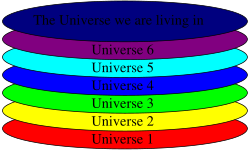
Some speculative theories have proposed that this universe is but one of a set of disconnected universes, collectively denoted as the multiverse. By definition, there is no possible way for anything in one universe to affect another; if two "universes" could affect one another, they would be part of a single universe. Thus, although some fictional characters travel between parallel fictional "universes", this is, strictly speaking, an incorrect usage of the term "universe". The disconnected universes are conceived as being physical, in the sense that each should have its own space and time, its own matter and energy, and its own physical laws. Thus such physical disconnected universes should be distinguished from the metaphysical conception of alternate planes of consciousness, which are not thought to be physical places. The concept of a multiverse of disconnected universes is very old; for example, Bishop Étienne Tempier of Paris ruled in 1277 that God could create as many universes as he saw fit, a question that was being hotly debated by the French theologians.
There are two scientific senses in which multiple universes can occur. First, disconnected spacetime continua may exist; presumably, all forms of matter and energy are confined to one universe and cannot "tunnel" between them. An example of such a theory is the chaotic inflation model of the early universe. Second, according to the many-worlds hypothesis, a parallel universe is born with every quantum measurement; the universe "forks" into parallel copies, each one corresponding to a different outcome of the quantum measurement. Authors have explored this concept in some fiction, most notably Jorge Borges' short story The Garden of Forking Paths. However, both senses of the term "multiverse" are speculative and may be considered unscientific; the fact that universes cannot interact makes it impossible to test experimentally in this universe whether another universe exists.
